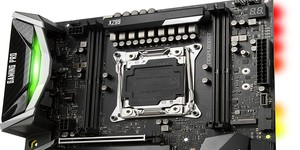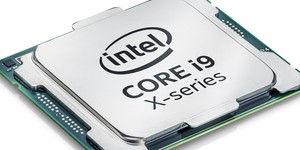
More L2 Cache, Less L3 Cache
One of the stand-out differences between Broadwell-E and Skylake-X is the arrangement of L2 and L3 cache. It was obvious fairly early on that the likes of the Core i7-6950X had considerably more L3 cache than its successor, the Core i9-7900X. However, this doesn't mean the new CPU is a cut-down version, because the L2 cache has been tweaked too. This has seen a four-fold increase from 256KB per core with the Core i7-6950X to a whopping 1MB per core with the Core i9-7900X. This could reduce the frequency with which the slower L3 cache is accessed, potentially increasing efficiency, IPC, and lowering latency. So, while the massive 25MB L3 cache of the Core i7-6950X might be useful in some circumstances for a 10-core CPU, it still adds up to a third layer that needs to be accessed, and anywhere that L2 cache is more important could see things swing in Skylake-X's favour.This also means that you have a tough job if you want to predict Skylake-X's performance - it's not just a 14nm refresh. This cache redesign means it not only differs significantly to Broadwell-E but also to mainstream Skylake - ie Core i7-6700K. Sure, they have fewer cores, but they too have significantly more more L3 cache than L2 cache, with just 256KB per core. Mega amounts of L3 cache are still on the cards, though, but to get 25MB you'll now need to step up to the $2000 Core i9-7980XE, which has an impressive 18MB L2 cache and 24.75MB L3 cache.
Improved Turbo Boost Max Technology 3.0
Something we really liked about AMD's Ryzen was the fact that despite the company's clear focus on multi-threaded performance, it appreciated that some applications still benefit more from lightly-threaded grunt or simply don't use more than one or two cores. Its SenseMI technology, in particular XFR, addressed this with single-core boosts up to 200MHz higher than the Precision Boost frequency. It was an added feature that drove as much hype as any other thanks to its seemingly intelligent design that made Ryzen more than just a bunch of cores. Intel, though, did get there first - last year, in fact, with Turbo Boost Max 3.0. If you forgot about it, we're not surprised, as it wasn't implemented nor supported very well.In a nutshell, the single best performing and most overclockable core was highlighted (this was identifiable in many EFIs), and Intel's software could boost that core to a much higher frequency than traditional Turbo Boost 2.0 would achieve, boosting performance in applications that were associated with it. It sounds great, but sadly few motherboards supported it, many had it disabled out of the box, and you had to install software and make sure things were working correctly too. In short, it was a faff, but the idea was good, and it was still a potentially very useful feature for stock speed users.
This time, though, things are hopefully going to be different. Intel has improved the technology in a number of ways. It's now natively supported in Windows 10. Assuming there's no issue with motherboard support, this should be a done deal. Secondly, while the original method was to boost a single core, Turbo Boost Max 3.0 now picks out and boosts two cores, further improving its utility. Note, however, that it is only supported on the Core i7-7820X and above, meaning the six-core Core i7-7800X and both Kaby Lake X parts will need to make do without it. This will potentially put quite a gap between the Core i7-7800X and Core i7-7820X in lightly threaded workloads.
There's a big step up in price when moving between these two chips too, with the Core i7-7820X demanding $599 while the Core i7-7800X will cost $389. The only consolation is that the Core i7-7800X costs significantly less than its predecessor, the Core i7-6800K, did at launch, which would have set you back $434. There will undoubtedly be some X299 boards at reasonable prices later this summer, so the entry fee to X299 could end up being a little less than X99.

MSI MPG Velox 100R Chassis Review
October 14 2021 | 15:04








Want to comment? Please log in.